Introduction
Yin and Yang
Yin Yoga is based on the Taoist concept of yin and yang, opposite and complementary principles in nature. Yin is the stable, unmoving, hidden aspect of an object, while Yang is its changing, moving, revealing aspect. These two objects always coexist, and everything in nature can be described in terms of its yin and yang.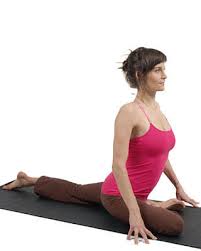
All forms of yoga can be described as Yin or Yang based on which tissues of the body are being targeted. A practise that focuses on gentle traction and the stretching of ligaments, tendons and fascia (connective tissue) is Yin yoga and a practise that focuses on exercising and stressing the muscles is Yang yoga.
How to Practise Yin Yoga
Be Relaxed, be Patient
Dense connective tissues (ligaments, tendons and fascia) do not respond to quick rhythmic repetitive stresses the way that muscles do. Connective tissues change and relax slowly after maintaining a constant stretch for two to five minutes. To properly stress the connective tissue around a joint, the muscles in that area must be relaxed. As a result, when practising Yin yoga it is important not to be anxious or aggressively and force your body into poses. When you begin a pose make a modest effort to approximate the pose as best as you can, and then patiently wait. The power and effectiveness of Yin yoga derives from time, not effort. Learning to relax as you hold a pose is an important skill to acquire, as it will allow you to release tension and get deeper into the pose.
Breathing
The key in Yin yoga is to breathe normally. It is important not to hold your breath, and particularly to not artificially alter your breathing into a rhythmic cadence. Each Yin posture will affect your breathing in a different way, so it would be counterproductive to try to control it.
Guiding Principles
1. Every yoga pose is experienced by and affects each person differently. Do not become fixated on “mastering a pose”. The poses are meant to be therapeutic, not to challenge your pride. Some poses may be uncomfortable but result in a healthy physiological response, while others may not. Be sensitive to how you feel while holding a pose and how your body respond afterwards and adapt your practice accordingly.
2. Forward bends are Yin and as a result are calming and can be held for a longer period of time. Backward bends are Yang and more stimulating to the body and do not need to be held as long.
3. Yin practice requires a smaller variety of poses than a Yang practice does.
4. Use pillows, blankets, and bolsters to support yourself if you find poses strenuous. Yin yoga should never be stressful. If you find yourself unable to relax, you are being too aggressive.
5. For effective long term Yin practice it is important to develop consistency and discipline. However, it is equally important to allow your practice to remain dynamic and to modify your practice routine to suit your needs.
Yin Postures
The following is a list of Yin Postures. The poses are to be done symmetrically or one leg at a time, as illustrated. Start by holding each pose for two minutes and progress up to four or five minutes maximum. Your practice should include four to eight poses depending on the time you have available and your needs. Over time you may vary the poses to add variety and balance to your practice.
| Pose | Technique | Illustration |
| Two Legged Butterfly-Stretches the lower spine and groin | – Sit with the soles of the feet touching and lean forward.- If you start with the feet closer to your groin, your groin muscles will be stretched more.- If you start with your feet further from your groin, the lower spine will be stretched more. | 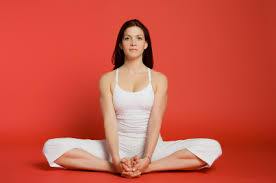 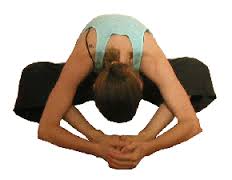 |
| One Legged Butterfly– Stretches the hamstrings and lower back | – Sit with one leg stretched forward and the other leg folded, with the foot near the opposite groin- Drop your chin to your chest, lean forward and try to grasp your ankle or foot.- The knee of the extended leg may be bent as long as you can feel the stretch in the back of your leg. | 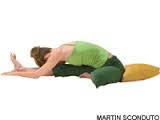 |
| Caterpillar-Stretches the legs and entire spinal column | -Sit with both legs out in front of you, with your feet either together or hip width apart.- Drop your chin to chest and lean forward to grasp your ankles or feet.- Try to keep your legs straight but don’t overdo it. A slight bend in the knees isokay as long as you feel the stretch. |  |
| Child-Stretches the spine | – Kneel with your buttocks on your heels and lean forward to rest your head on the floor.-Arms should rest comfortably beside you or in front of you. | 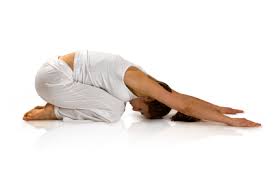 |
| Two Legged Cradle– Stretches the spine and gluteal musculature (hip extensors) | – Lying on your back, bring both knees to your chest and clasp both hands around the lower part of your knees.- For an additional upper spinal stretch you may tuck your chin to your chest. |  |
| One Legged Cradle– Stretches the spine and unilateral gluteal musculature (hip extensors) | – Lying on your back, bring one knee to your chest (Gluteus maximus stretch)-Lying on your back, bring one knee to the opposite chest (Gluteus medius stretch) | 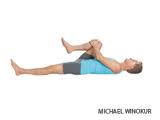 |
| Dragon– one leg-Stretches the groin, ankles and hip flexors. | – Place one foot forward in front of you and rest the opposite knee on the floor behind you.- Slowly lower the thigh of your rear leg to the floor so you feel a stretch on the top and front of the thigh | 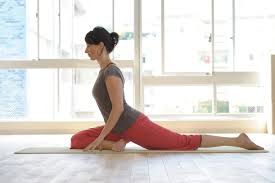 |
| Dragonfly– stretches the hamstrings, groins and lower spine | – Sitting with your legs spread out 90° or more apart- To increase the stretch, begin to lean forward, first touching your hands, your elbows, and eventually your forehead to the floor. |  |
| One Legged Gecko-Stretches the groin, ankles and hip flexors | -Similar to Dragon but front leg is more to the side, which allows your body to lean forward farther.- Start by having your hands touch the floor. Progress to having your forearms touch the floor as your flexibility improves. | 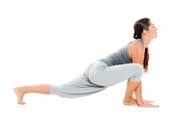 |
| Pentacle– Used between difficult poses to allow the body to relax and recover. | – Lie on your back with your arms and legs spread out in a comfortable and unguarded position.-Close your eyes and let your recumbent body sink into the floor | 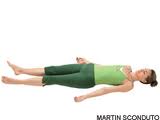 |
| Saddle– both legs or one leg at a time- Stretches the feet, knees, thighs and hip flexors | – Sitting on your feet with your knees spread apart.- As your flexibility improves, try to lower yourself backwards and support your weight first on your hands, then your forearms and finally on your upper back.Note: coming out of this pose can be challenging, and for many it may be less stressful to roll or lean to one side and unfold your legs one at a time. |  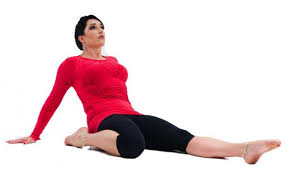 |
| Seal– Re-establish the lumbar curve and stretch the hip flexors | – Lie on your stomach with your hands on the floor in front of and to the sides of the shoulders. The hands should be turned slightly outwards.-Straighten your elbows and lift your chest and belly off the floor.Note: if you keep your legs apart, the stress will be more localized to the lower back. If you keep your legs together the stress is more evenly distributed along the entire spine. | 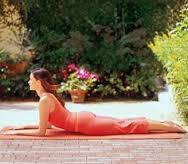 |
| Square– Stretches the groins, the lower back, and opens up the external rotation of the hips. | – Sit with your legs folded in front of you.-Pick up one leg and lay the outer bone of the ankle on top of your other thigh near the knee.- Try to lean forward to feel the stretch in your lower spine. | 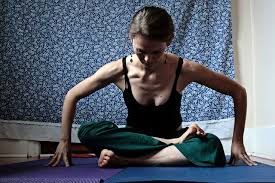 |
| Sleeping Swan– Externally rotates and opens up the hip and stretches piriformis, tensor facia lata and ilio tibia band. | – Get on your hands and knees and then move one knee back roughly a foot. Place the other foot in front of the first knee and then slide the first knee backwards as far as possible so your pelvis lowers towards the floor.-Lean forward | 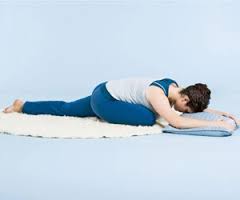 |
| Swan-Externally rotates and opens up the hip, and stretches the hip flexors of the straight leg and piriformis of the bent knee leg. | – Get into the sleeping swan position.-Use your arms to push the chest up and extend as far back as you can. |  |
| Snail– Stretches the entire spinal column | Lay on your back with hands underneath your buttocks and then roll your legs up over your head. Try to keep your knees as straight as possible.-You may place your hands on your hips for balance and support. |  |
| Stirrup– one or both legs- Stretches the groin | – Lie on your back with your legs extended up n the air.- Bend your knees and place your hands on your shins- Open your knees. Your feet should stay the same width apart as your knees: the wider your knees the stronger the stretch. |   |
| Spinal Twist– Stretches the lower back and lateral hip extensors | – Lie on your back and bring both knees to your chest.-Cross one leg over the other and then twist both legs to the opposite side.-Extend the opposite arm away from the twist, and turn your head that same way to increase the stretch of the twist. The goal is to try to get that opposite shoulder as close to the floor as possible. | 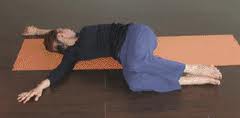  |
Summary
Yin yoga uses long – two to five minutes- held relaxed or passive floor postures to stretch and stimulate the deep connective tissues of the body. This form of yoga is accessible to almost anyone regardless of age, fitness level or health condition. Yin yoga is an ideal complement to dynamic aerobic and muscular resistance exercises and “Yang” forms of yoga. Try it; you will love it, and you will emotionally and physically benefit greatly from it.
If you’d like more info please contact Mike.
